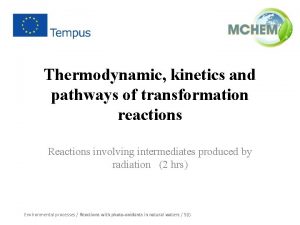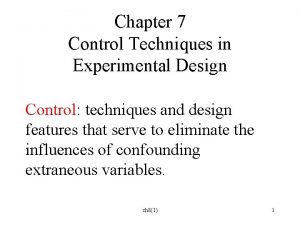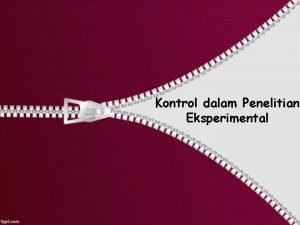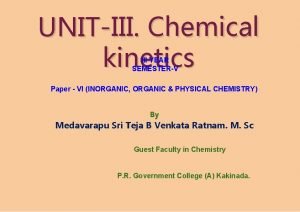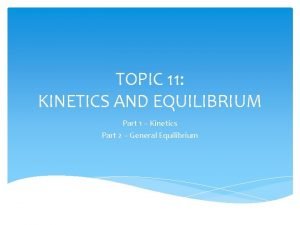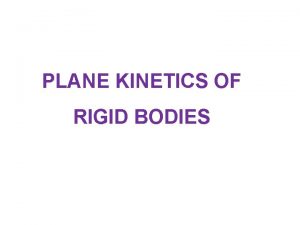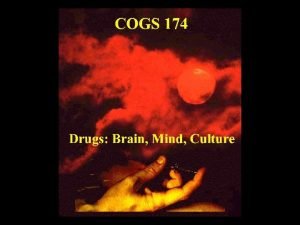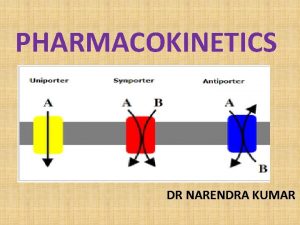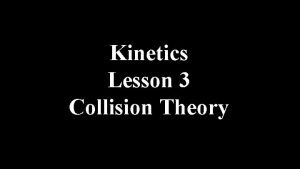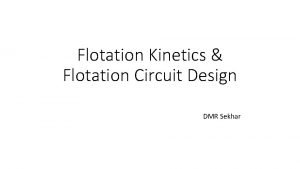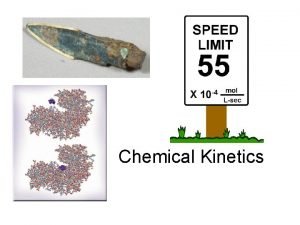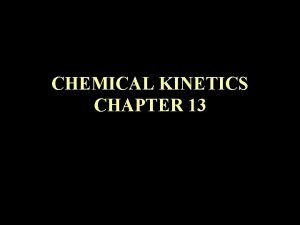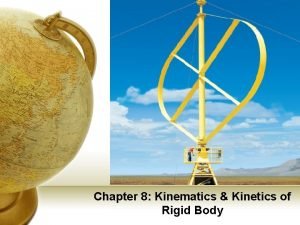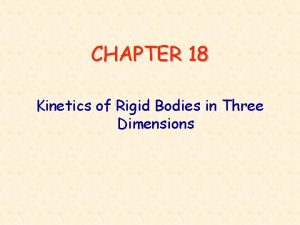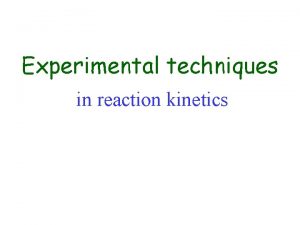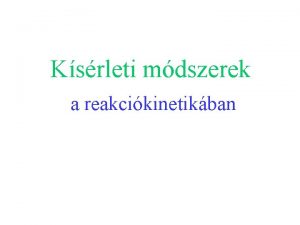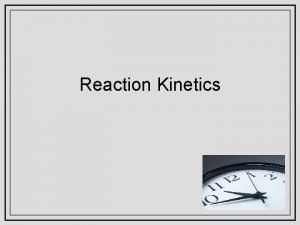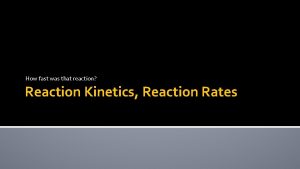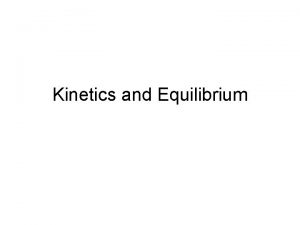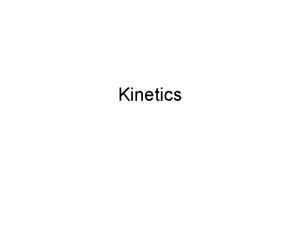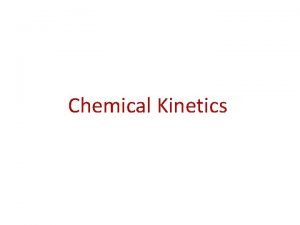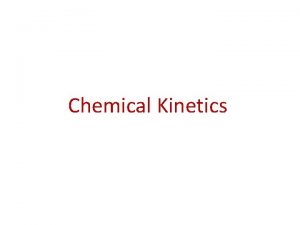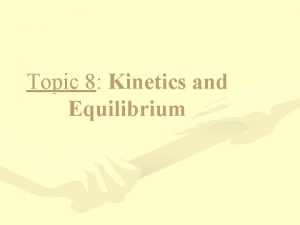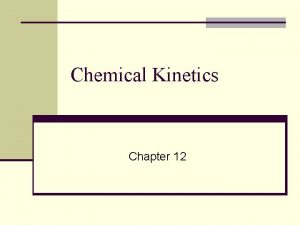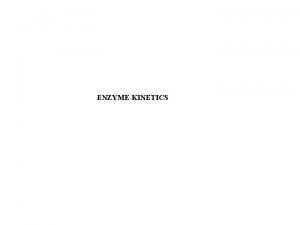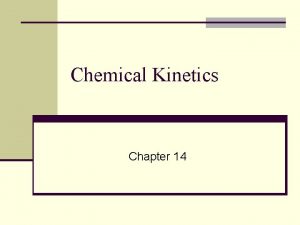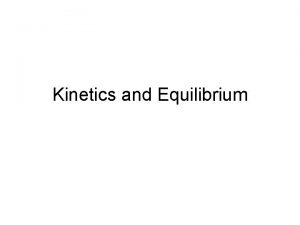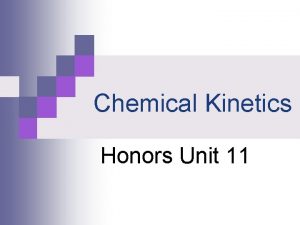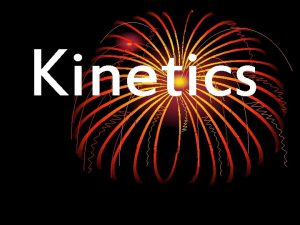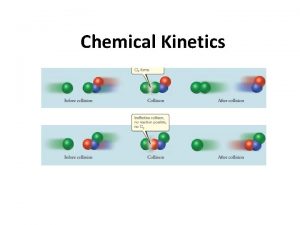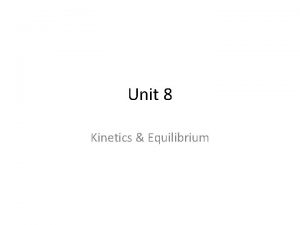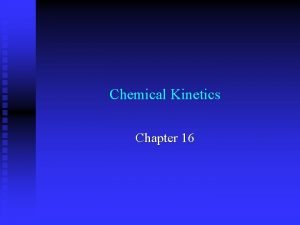Ksrleti mdszerek Experimental techniques in reaction kinetics Techniques
























- Slides: 24

Kísérleti módszerek Experimental techniques in reaction kinetics

Techniques classified Batch reactors vs. flow reactors Online methods: real-time in situ detection Offline methods: — aliquot from the batch — “quenched flow” Pseudo-first order (isolation or flooding) method (only if relative concentrations are available) Unbiased; higher precision Biased; lower precision

“classical” techniques Thermometer Electrode (time-limit: manipulation time; ~ 1 s) C 4 H 9 Cl + H 2 O → Inlet for C 4 H 9 Cl → C 4 H 9 OH + H+ + Cl– Conductivity meter Reaction mixture PC or chart recorder Voltage Magnetic stirrer Time Thermostatted jacket

Discharge flow (time-limit: mixing time; ~ 1 ms) To diffusion („gyorsáramlásos módszer”)

Resonance fluorescence detection (RF) Photomultiplier tube Microwave discharge cavity H 2 / He mix inlet Hydrogen Lamp outlet Processes in the detection cell Processes in Resonance Lamp a) H atoms absorb photons and become electronically excited b) A portion of isotropically emitted fluorescence photons is detected a) MW radiation dissociates some H 2 b) H atoms absorb energy and become electronically excited c) H atoms relax, emit charac-teristic radiation directed into the cell

(LIF) Excitation pulse (282 nm) v’ = 2 v’ = 0 Fluorescence (308 nm) Energy Laser induced fluorescence detection v’’ = 2 v’’ = 0 etc. v’ = 1 Excitation laser tuned to one particular rotational level 0

Mass spectrometry He buffer gas Quadrupole mass selector To pumps Ion detector C 2 H 5 + detected Flow tube Movable injector (reactor) To pumps Ion source To pumps Microwave discharge Cl 2 / He Cl + C 2 H 6 → HCl + C 2 H 5 + O 2 → C 2 H 6 O 2 → C 2 H 4 + HO 2

Continuous liquid flow tube („folyamatos áramlásos reaktor”) Motor driven syringe plungers Source Reactant A Mixing chamber Reactant B Detector Flow tube Moveable detector system (spectrometer)

Stopped flow system („megállított áramlásos reaktor”) Computer control and data acquisition Limit switch Effluent Reactant A Motor driven syringe plungers Reactant B Mixing chamber Reactor Spectrometer

Shock tube Real time detection Reaction mixture High pressure inert driver gas Diaphragm Pressure Before diaphragm breaks Pressure After diaphragm has broken Incident shock

Flash photolysis (time-limit: flash pulse width; ~ 1 μs) Nobel Prize: Norrish, Porter; 1967 Photolysis flash Spectrograph Reactor tube Detection flash

(time-limit: laser pulse width; ~ 1 μs down to 1 fs) Beam dump Heatable stainless steel reaction vessel Monochromator PMT To exhaust Valve to control pressure in reaction vessel Xenon arc lamp Slow premixed gas flow Flow controller Digitizer (A/D) Computer control and data acquisition Flow controller Gas inlets Laser photolysis

időfelbontás Increase in time resolution 1011 times increase within 36 years!! time, seconds amplified lasers + pulse compression picosecond lasers (ring lasers) nanosecond lasers (mode locking) flash photolysis + relaxation flow methods year

Principles of laser operation (”lasing”) Light Amplification by Stimulated Emission of Radiation Pumping energy Tuning device Gain medium High reflector (non -transparent) Auxiliary parts Output coupler (partially transparent)

Pulsed lasers Pumping energy Tuning device Gain medium High reflector (non -transparent) Saturable absorber Output coupler (partially transparent)

Colliding Pulse Mode-locked lasers (CPM lasers) Tu n de ing vic e Amplifier Output coupler Absorber Pumping laser

időskála 2 CPU clock cycle time atomic nucleus - neutrino interaction nuclear motion in atomic nuclei yocto- zepto- femto- pico- second 10 -3 10 -6 10 -9 10 -12 10 -15 10 -18 10 -21 10 -24 micro- 1 milli- 103 electronand energytransfer molecular vibration molecular rotation nano- one minut 106 kilo- length of a day 1012 109 giga- 1015 mega- lifetime of the triplet excited state tera- human lifespan lifetime of the singlet excited state atto- appearance of humans vibrational relaxation solvation peta- the age of Earth Time window of elementary reactions molecule - photon interaction Time scale

pump-probe Spectroscopy with femtosecond time resolution: experimental arrangement reference detector Nd: YAG laser probe sample Ar- ion laser excitation H 2 O amplifier delay (1 fs = 0. 3 CPM laser m path length) Laser technics: http: //femto. chem. elte. hu/kinetika/Laser. htm

pump-probe 5 Principles of the femtosecond experiment potential energy ultrashort pulse coherence and selectivity 1 fs = 0. 3 m path length excitation (Ig) measurement (Im) reaction coordinate time Pulse width: 10… 100 fs

pump-probe 6 Experimental results LIF signal potential energy ICN → I···CN → I + CN reaction coordinate delay time, fs

Collimators and velocity selectors Heated oven Molecular beam Reaction dynamics Moveable detector Effusive beam Reaction chamber 10– 7 torr Molecular flow (collision free) Continuum flow (collisional relaxation) Second stage pumping First stage pumping High pressure source (> 300 torr)

Angular dependence Scattering angle in a centre of mass system Density map: HCl intensity

Angular and energy dependence F + D 2 DF(v) + D v=1 v=2 Constant total energy v=3 0° 180° v=4 Contour lines: equal velocity of DF

State selective optical detection CX molecules Microwave discharge generated A atoms B atoms from microwave discharge Sapphire window Liquid N 2 cooled reaction vessel (cryopump) Split mirror optics (White cell) to collect and focus emission onto detector To pumps
 Kinetics reaction
Kinetics reaction Experimental vs non experimental
Experimental vs non experimental Research approaches and designs
Research approaches and designs Experimental vs non experimental research
Experimental vs non experimental research Experimental vs nonexperimental
Experimental vs nonexperimental Experimental vs non experimental
Experimental vs non experimental Counterbalancing
Counterbalancing Kontrol dalam penelitian eksperimen
Kontrol dalam penelitian eksperimen Reaction order
Reaction order E1cb elimination reaction
E1cb elimination reaction Leukoerythroblastic reaction vs leukemoid reaction
Leukoerythroblastic reaction vs leukemoid reaction Neutron emission
Neutron emission Definition of chemical kinetics in chemistry
Definition of chemical kinetics in chemistry Kinetics and equilibrium
Kinetics and equilibrium Ion trapping definition
Ion trapping definition Planar kinetics of a rigid body
Planar kinetics of a rigid body Difference between zero and first order kinetics
Difference between zero and first order kinetics Difference between 1st order and zero order kinetics
Difference between 1st order and zero order kinetics Collision theory of kinetics
Collision theory of kinetics Types of reactions grade 11
Types of reactions grade 11 Kinetics flotation reagents
Kinetics flotation reagents Half life chemical kinetics
Half life chemical kinetics Chemical kinetics definition
Chemical kinetics definition Kinetics of rigid bodies
Kinetics of rigid bodies Motion of rigid body in three dimensions
Motion of rigid body in three dimensions
